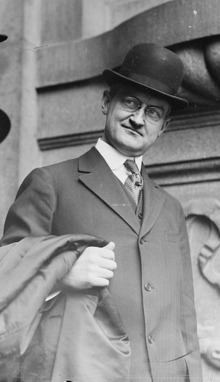Preceded by Alfred Coxe Name Martin Manton Religion Roman Catholicism | Political party Democratic Party Preceded by Charles Hough Role Judge | |
 | ||
Born August 2, 1880New York City, New York, U.S. ( 1880-08-02 ) Similar People Woodrow Wilson, Louis Brandeis, John Hessin Clarke, James Clark McReynolds | ||
Martin Thomas Manton (August 2, 1880 – November 17, 1946) was a United States federal judge in New York City, who resigned and served time in prison for accepting bribes while in office. In 1916, he was the youngest federal judge in the United States. Manton was the first federal judge to be convicted of bribery.
Contents
Early life
Manton was born on August 2, 1880. He graduated from Columbia Law School in 1901 and worked as a lawyer in private practice in Manhattan for 15 years. In 1915 he was the lawyer for Charles Becker, the New York City police officer who was convicted and executed in the Rosenthal murder trial.
District Judge
In 1916, President Woodrow Wilson named Manton as a Judge of the United States District Court for the Southern District of New York.
Circuit Judge
After two years on the District Court, in 1918 Manton was appointed to the United States Court of Appeals for the Second Circuit, the federal appeals court for New York, Connecticut, and Vermont.
In 1922, President Warren G. Harding considered appointing Manton to the Supreme Court to succeed Justice William R. Day in what was then regarded as the "Catholic seat" on the Court. Manton encountered opposition led by Chief Justice William Howard Taft, and Harding ultimately appointed Justice Pierce Butler to the seat. Manton continued to serve on the Second Circuit, which during that era was one of the most distinguished courts in American history, including judges such as Learned Hand, Augustus Hand, Charles Merrill Hough, and Thomas Walter Swan.
During the 1930s, Manton's seniority made him the Senior Circuit Judge of the Court (the rough equivalent of the Chief Judge position today). He wrote a memorable dissenting opinion in the obscenity litigation instigated by Bennett Cerf concerning the book Ulysses by James Joyce, United States v. One Book Entitled Ulysses, 72 F.2d 705 (2d Cir. 1934). Judges Learned Hand and Augustus Hand decided that the book was not obscene, but Manton voted to ban it. Manton was also involved in a series of controversial decisions concerning control and financing of the companies then operating the New York City Subway.
Bribery conviction
Manton suffered severe financial reverses during the Great Depression and began to accept gifts and loans from persons having business before his court, some of which constituted outright bribes for selling his vote in pending patent litigation. Rumors of corruption spread and in 1939, Manton resigned under pressure of investigations by Manhattan District Attorney Thomas E. Dewey, who wrote a letter to the Chairman of the House Judiciary Committee recommending impeachment proceedings, and by a federal grand jury.
Following his resignation, Manton was indicted in the United States District Court for the Southern District of New York where he once sat as a judge. The government was represented at trial by John T. Cahill, the United States Attorney for the Southern District of New York, and Assistant United States Attorneys, Mathias F. Correa, Jerome Doyle, Frank H. Gordon and Silvio J. Mollo. Honorable William Calvin Chestnut of the District of Maryland presided over the jury trial at which Manton called former Democratic Presidential candidates Alfred Smith and John W. Davis as character witnesses. Manton became the first federal judge convicted of accepting bribes.
Manton's conviction was affirmed by a specially constituted Second Circuit panel consisting of retired Supreme Court Justice George Sutherland, Supreme Court Justice Harlan Fiske Stone, and newly appointed Second Circuit Judge Charles Edward Clark. Manton was sentenced to two years in Lewisburg Federal Penitentiary and served 17 months.
Following release from prison, he moved to Fayetteville, New York, where he died on November 17, 1946. To this day, a park in Queens, NY bears Manton's name.
Legacy
The 1940 Pulitzer Prize for reporting was awarded to S. Burton Heath for his coverage of the Manton trial for the New York World-Telegram.
